В самом BIOS нет инструментов для отката системы, но его можно использовать для того, чтобы запустить восстановление с установочного носителя. Благодаря правильной настройке BIOS мы получим доступ к инструментам, которые помогут вернуть Windows в работоспособное состояние.
Подключаем к компьютеру установочный съёмный носитель с дистрибутивом Windows. По умолчанию он будет загружаться уже после жёсткого диска. Но мы можем поменять приоритет через BIOS.
- Перезагружаем компьютер.
- Заходим в BIOS.
- Находим раздел с приоритетом загрузки.
- Выставляем на первое место установочный накопитель, а на вторую позицию — жёсткий диск.
Главная сложность в этой операции — найти в BIOS настройки приоритета. Вот несколько распространённых вариантов.
- Phoenix Award BIOS — переходим в раздел «Advanced BIOS Features», выбираем пункт «Hard Disk Boot Priority», меняем накопители местами.
- AMI BIOS — переходим на вкладку «Boot», выбираем пункт«Hard Disk Drives», в строке «1st Drive» ставим установочный накопитель.
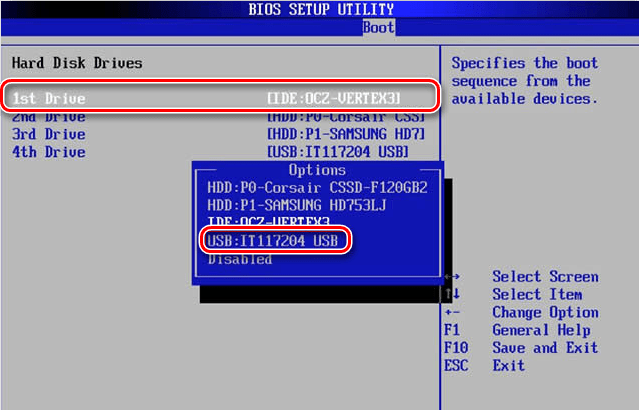
Изменение приоритета загрузки
В интерфейсе UEFI разобраться проще. Часто список устройств с приоритетом загрузки вынесен на первый экран, так что нам остаётся только перетащить установочный диск на первое место.
Восстановление системы
После перезагрузки компьютера появится интерфейс установщика. На первом шаге мастера мы выбираем язык, формат времени и метод ввода. Все параметры можно оставить по умолчанию, потому что саму установку проводить мы не будем. Нажимаем «Далее» для перехода к следующему экрану.
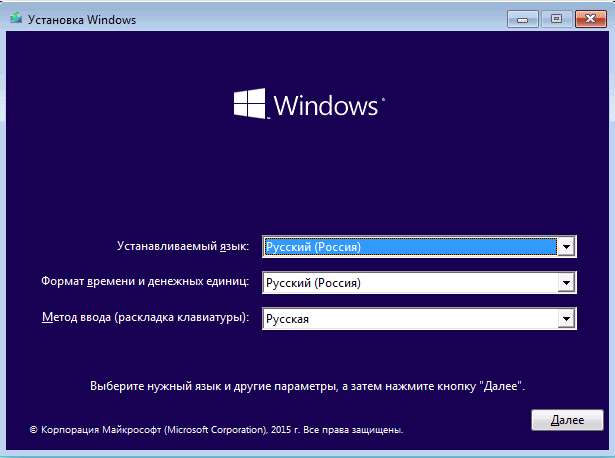
Здесь можно ничего не менять
В окне установщика кликаем по ссылке «Восстановление системы».
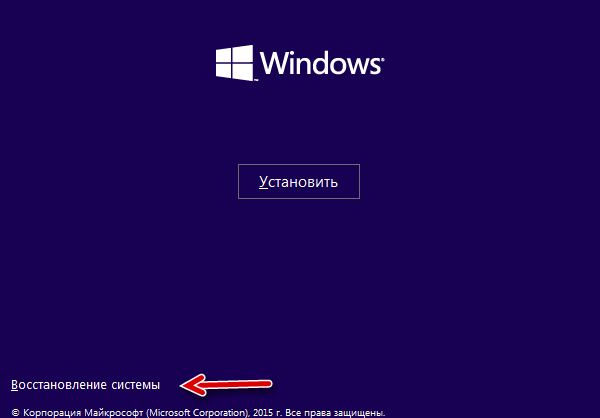
Переходим в среду восстановления системы
Появится экран с доступными действиями. Выбираем пункт «Диагностика». Затем переходим в «Дополнительные параметры». Здесь мы видим несколько вариантов восстановления системы.
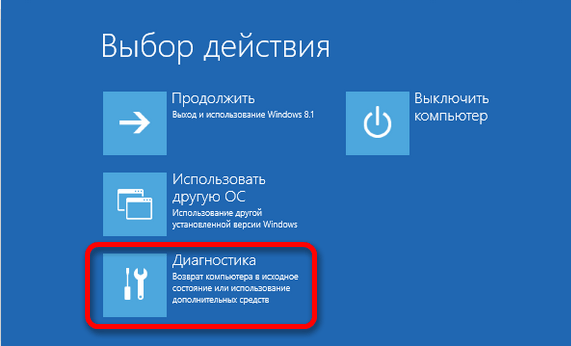
Все инструменты восстановления системы представлены в этом разделе
Если у нас есть контрольные точки восстановления, то выбираем первый способ — «Восстановление системы». При его запуске отобразится такое же окно, как при работе в среде Windows. В нём мы выбираем из списка желаемую дату для отката и запускаем восстановление.
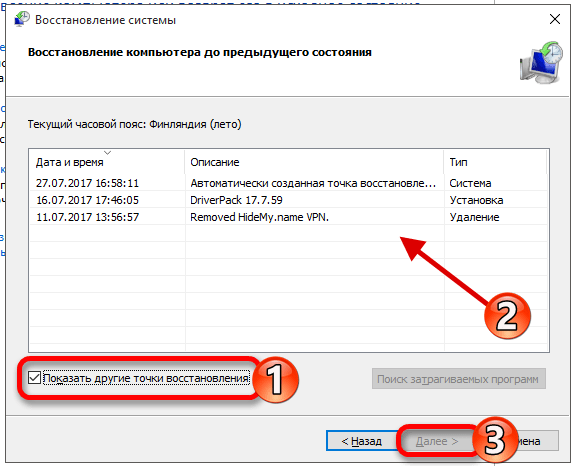
Выбираем подходящую точку
После завершения процедуры компьютер автоматически перезагрузится. Так как в BIOS выставлен приоритет флешки, то мы снова попадём на экран установки Windows. Чтобы проверить, заработала ли система, извлекаем загрузочный диск или меняем приоритет в BIOS, выставляя на первое место жёсткий диск.
Если откат системы к контрольной точке не решил проблему, то снова подключаем флешку (или меняем приоритет) и пробуем восстановить Windows другими способами — например, с помощью командной строки. Выполняем те же действия, чтобы добраться до дополнительных параметров диагностики, и выбираем подходящий режим восстановления.
Запуск дополнительных параметров без установочного диска
Если установочного диска нет, можно перейти к дополнительным параметрам загрузки другими способами. Главное, чтобы Windows загружалась хотя бы до приветственного экрана. Даже если нельзя добраться до рабочего стола, получится использовать такой метод:
- На экране входа в систему находим кнопку выключения. Зажимаем клавишу Shift и нажимаем на неё. Выбираем режим «Перезагрузка».
- Не отпуская Shift, нажимаем «Всё равно перезагрузить».
- После появления меню «Выбор действия» отпускаем клавишу Shift.
- Нажимаем «Продолжить».
- Выбираем «Диагностику» — «Дополнительные параметры» — «Восстановление системы».
Есть и другие способы перехода к дополнительным параметрам загрузки, но они работают только из среды Windows, так что особого смысла в нашем случае в них нет. Если мы можем попасть в меню «Пуск», то можем запустить восстановление системы без сложных манипуляций с перезагрузкой.
Post Views: 20 324
Resetting Windows can help resolve different problems related to your computer/laptop. But sometimes, it may be hard for you to reset your system. You should read this blog if you don’t know how to factory reset Windows 11 from BIOS. This guide from EaseUS will show you how to reset a laptop seamlessly in a few simple steps. Let’s read about the factor reset Windows process and related sections.
Backup Your Computer Before Factory Reset
Before you start resetting Windows, you should take a backup of your data. Keeping yourself safe from data loss due to any unexpected error is compulsory. You can use built-in backup tools of Windows 11 to create a system image, but it is not as fully equipped as you might expect.
It will lose your data if your system faces a technical issue and experiences an unexpected problem. In this situation, the best approach is using EaseUS Todo Backup. This specific tool is designed to back up your data.
It can back up your files, systems, disks, partitions, computer apps, etc., and save the backups in various locations. It lets you transfer Windows to another computer without boot issues and perform full, incremental, and differential backups.
EaseUS Todo Backup
- Restore a Windows system image to a smaller hard drive
- One-click backup and instant recovery with high efficiency
- Offer 250G Cloud storage for free to back up files to Cloud
- Clone a hard drive and image a hard disk in several steps
- Create a WinPE bootable disk for Windows PCs with 3 steps
After reinstalling Windows 11, you can download data from the cloud. Moreover, you can schedule the backup process to keep files in the cloud without hassle. To keep users at ease, it also allows you to back up selected files, folders, or disks. In short, EaseUS Todo Backup is the perfect pick for backing up data before performing a factor reset.
Once you have finished the backup procedure, you should move towards the factory reset Windows 11 from the BIOS phase. We have listed the steps with detailed descriptions about performing the factory reset via BIOS for your assistance.
Access BIOS
Firstly, you must access BIOS settings using a specified key while your system turns on. Mostly, you can use the F1, F2, Del, and Esc keys. If you don’t know about the keys, you can consult with your device’s manual. Keep pressing these keys until you get a BIOS setup screen.

Change Settings
From the BIOS screen, navigate to the «Exit» tab and select «Load Setup Defaults«. It will help your system identify what you want in return when you end up with the factory reset. After selecting it, choose «Save and Exit» or press F10 to save your changes.

Start Factory Reset
After pressing the above-mentioned key, your system will restart automatically. Now, you can choose the «Troubleshoot» option from the screen and then the «Reset this PC» option to start this process. You may have to click on the «Reset» button again for confirmation.

After the factory reset, you will be led to the Windows setup process. Follow the on-screen prompts to set up the preferences, create your user account, and personalize your system.
Is this article helpful? If so, share it on your social media to help more people.
When to Factory Reset from BIOS Windows 11
The question that comes to mind about factory reset Windows 11 is why you should need this. There can be multiple reasons behind this selection, which are related to Windows. The most common reason is malware-infected operating systems.
Your system may have been affected by corrupted software/programs. In this case, your system will experience slow processing. By factory resetting your Windows, you will get a fresh system with the same processing speed.
Secondly, it might be possible that you have made some changes to BIOS that affect the processing. To undo those changes, you must be a technical professional. But if you are not, you should go ahead and factory reset Windows.
Moreover, the factory reset can save the default settings on your system. If you cannot find the change you have made that is damaging the performance, you should choose the factory reset option.
In short, whenever your system is experiencing a problem, and you cannot find it, the safest approach is to factory reset Windows 11 from BIOS.
Bonus Tip: Windows 11 Factory Reset from Boot Without Password
If you don’t know the password of your Windows, you may not be able to access the settings of your system. It means that you can’t reset Windows using the above method. In this regard, you can go with this process and factory reset Windows 11 without signing in.
You only have to ensure that you have connected the boot device to reinstall Windows on your laptop. After that, you must follow these simple steps to proceed with this process.
Step 1. Turn on your system and press a dedicated key like F2, F12, etc. (It depends on your laptop model, such as Dell, ASUS, Lenovo, Acer, etc.)
Step 2. Click on the «Repair Your Computer» from the «Advanced Startup» screen.
Step 3. Tap on «Troubleshoot» and then «Reset This PC.»

Step 4. Hit the «Reset Options» and then choose «Keep my Files» or «Remove Everything» as per your requirements
Step 5. Once done, follow the on-screen instructions to reset Windows 11 from BIOS.
Be mindful that choosing the «Remove everything» option will remove all files from your system. So, it is recommended to go with the «Keep my Files» option and check if the issue has been resolved. If it isn’t solved yet, you can choose another option.
To Wrap Things Up
We hope you have learned how to factory reset Windows 11 from BIOS by reading this guide. For your assistance, we have also shared the process to reset the PC, even if you don’t know the password. With this, you can get your system back to normal.
However, the most important thing to consider in this regard is to take the data backup with a free backup tool like EaseUS Todo Backup. It will help you factory reset your computer without losing data and store your personal files even if you have reset all settings. In short, it will be a safe way to keep files and get your system back on the main track after the removal of malware-affected programs.
FAQs on Factory Reset Windows 11 from BIOS
1. Does resetting BIOS erase Windows?
No, resetting BIOS doesn’t erase Windows from your system. But it will remove the files from the disk or clean it as per your instructions.
2. How do I factory reset Windows 11 without settings?
You can factory reset Windows 11 without settings via the Boot menu. Here are the steps to follow.
- Force restart your system by pressing the keys.
- Choose «Troubleshooting» from the options and then «Reset this PC.»
- Then, you need to choose the files that you want to keep on your system.
- Click on the «Reset PC» button to accomplish the task or follow the on-screen instructions.
3. How to reset Windows 11 from the boot when the PC doesn’t boot?
If your PC doesn’t boot, you should go with these steps to factory reset Windows 11.
- Start the computer and enter «Windows Recovery Mode.»
- Go to «Advanced Options» and then choose «Troubleshoot.»
- Tap on «Reset this PC» and choose the files storage option.
- Click the «Reset» button to finish this process.
Если вы видите это сообщение, значит, произошла проблема с загрузкой файлов в стилей (CSS) нашего сайта. Попробуйте сбросить кэш браузера (Ctrl+F5).
Если это не поможет, а вы находитесь в регионе, где возможны ограничения интернет-трафика с российских серверов — воспользуйтесь VPN.
|
Компьютер не включается совсем, даже безопасный режим, как восстановить через bios? Никакого отката через биос не существует. Откат можно сделать только двумя способами:
автор вопроса выбрал этот ответ лучшим Иван Анге 11 лет назад откат, хз как, но я обновлял биос через флешку. когда биос полетел, скачал сайта производителя биос последний и просто обновил. И всё заработало. Есть только одна проблема) если биос полетел у тебя никуда не пускает) и если у тебя только один комп) то беда) или к соседу) yuriy 11 лет назад через bios можно настроить загрузку с cd-rom или флешки, загрузится с winPE а там уже можно попробывать поправить систему Знаете ответ? |
Все способы:
- Что необходимо для начала восстановления
- Способ 1: Использование установочного носителя
- Способ 2: «Безопасный режим»
- Вопросы и ответы: 9
«Восстановление системы» — это функция, которая встроена в Windows и вызывается при помощи установщика. С её помощью вы можете привести систему к тому состоянию, в котором она была на момент создания той или иной «точки восстановления».
Что необходимо для начала восстановления
Сделать «Восстановление системы» чисто через BIOS невозможно, поэтому вам потребуется установочный носитель с той версией Windows, которую нужно «реанимировать». Его придётся запускать через BIOS. Также вам нужно убедиться в наличии специальных «точек восстановления», которые позволят сделать откат настроек к рабочему состоянию. Обычно они делаются системой по умолчанию, но если таковых не обнаружится, то «Восстановление системы» станет невозможным.
Также нужно понимать, что при проведении процедуры восстановления есть риск потерять некоторые пользовательские файлы или нарушить работоспособность программ, которые были установлены недавно. В этом случае всё будет зависеть от даты создания «Точки восстановления», которую вы используете.
Способ 1: Использование установочного носителя
В этом способе нет ничего сложного и он является универсальным практически для всех случаев. Вам понадобится только носитель с правильно записанным установщиком Windows.
Читайте также: Как создать загрузочную флешку
Инструкция к нему выглядит следующим образом:
- Вставьте флешку с установщиком Windows и перезагрузите компьютер. Не дожидаясь начала загрузки ОС, войдите в BIOS. Чтобы сделать это, используйте клавиши от F2 до F12 или Delete.
- В BIOS нужно установить загрузку компьютера с флешки.
- Если вы используете обычный CD/DVD-диск, то первые два шага можно пропустить, так как загрузка установщика начнётся по умолчанию. Как только появится окно установщика, выберите язык, раскладку клавиатуры и нажмите «Далее».
- Теперь вас перебросит в окно с большой кнопкой «Установить», где нужно выбрать в нижнем левом углу «Восстановление системы».
- После откроется окно с выбором дальнейших действий. Выберите «Диагностика», а в следующем окне «Дополнительные параметры».
- Там нужно выбрать «Восстановление системы». После вас перебросит в окно, где потребуется выбрать «Точку восстановления». Выбирайте любую доступную и жмите «Далее».
- Начнётся процесс восстановления, который не требует участия пользователя. Спустя приблизительно полчаса или час всё завершится и компьютер перезагрузится.
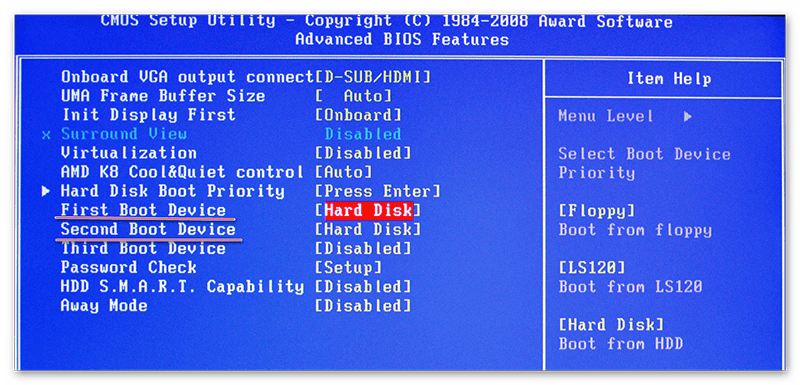
Подробнее: Как установить загрузку с флешки в BIOS
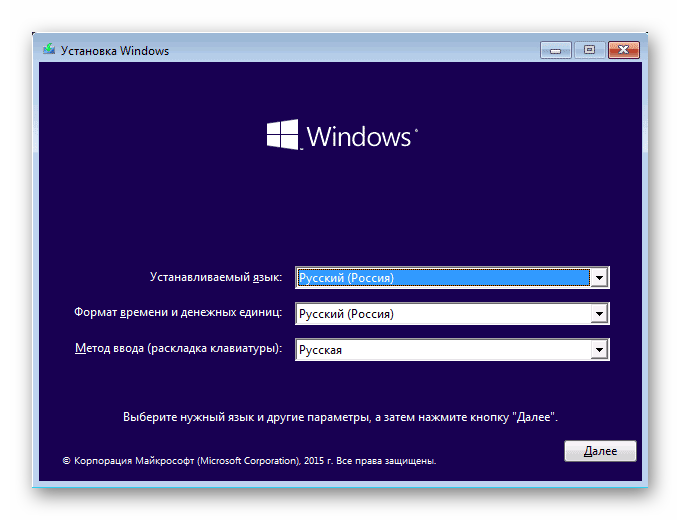

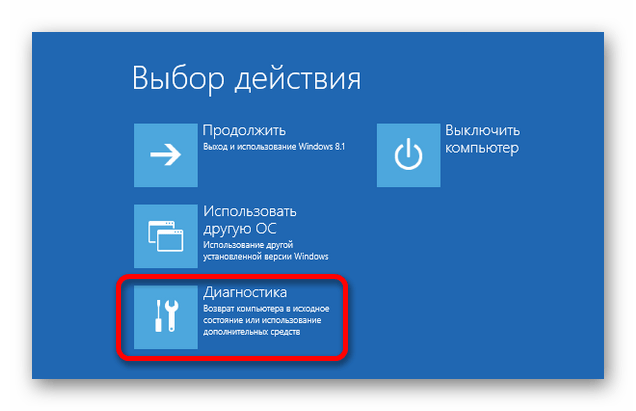

На нашем сайте вы также можете узнать о том, как создать точку восстановления на Windows 7, Windows 10 и резервную копию Windows 7, Windows 10.
Если у вас установлена Windows 7, то пропускайте 5-й шаг из инструкции и жмите сразу на «Восстановление системы».
Способ 2: «Безопасный режим»
Данный способ будет актуален в том случае, если у вас нет носителя с установщиком вашей версии Windows. Пошаговая инструкция к нему выглядит следующим образом:
- Войдите в «Безопасный режим». Если у вас не получается запустить систему даже в этом режиме, то рекомендуется воспользоваться первым способом.
- Теперь в загрузившейся операционной системе откройте «Панель управления».
- Настройте отображение элементов на «Мелкие значки» или «Крупные значки», чтобы увидеть все пункты панели.
- Там найдите пункт «Восстановление». Перейдя в него, вам нужно выбрать «Запуск восстановления системы».
- После чего откроется окно с выбором «Точек восстановления». Выбирайте любую доступную и жмите «Далее».
- Система начнёт процедуру восстановления, по завершению которой перезагрузится.
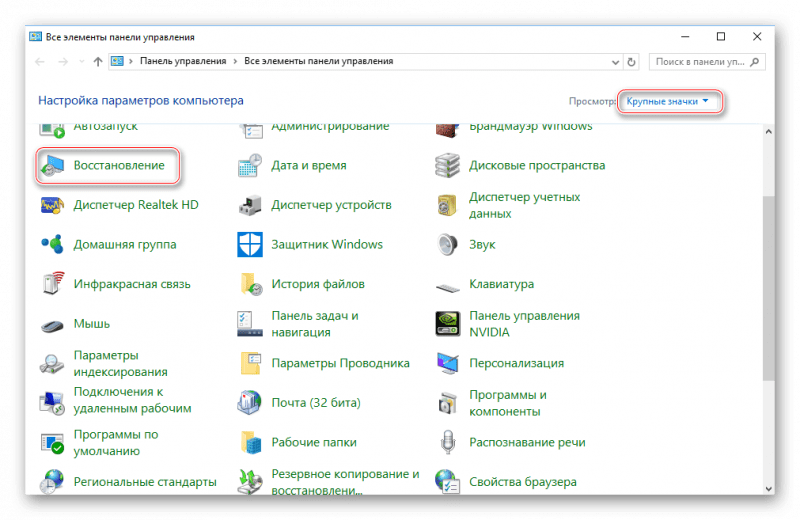

У нас на сайте вы можете узнать о том, как войти в «Безопасный режим» на ОС Windows XP, Windows 8, Windows 10, а также о том, как войти в «Безопасный режим» через BIOS.
Чтобы восстановить систему, придётся использовать BIOS, но при этом большая часть работ будет производиться не в базовом интерфейсе, а в «Безопасном режиме», либо в установщике Windows. Стоит помнить, что для этого также жизненно необходимы точки восстановления.
Наша группа в TelegramПолезные советы и помощь
-
Home
-
News
- How to Perform a Windows 10/11 Factory Reset from BIOS
How to Perform a Windows 10/11 Factory Reset from BIOS
By Stella | Follow |
Last Updated
If you don’t know how to factory reset Windows 10 or Windows 11 from BIOS, this article is helpful. You can find a full instruction here. Additionally, if your computer cannot boot, you can try MiniTool Power Data Recovery Boot Disk to rescue your files before factory reset.
Why Do You Need to Factory Reset Windows from BIOS?
Factory resetting your Windows 10 or Windows 11 computer from the BIOS can be a lifesaver when your operating system is malfunctioning, corrupted, or you simply want to start fresh. This process allows you to restore your computer to its original state, removing all personal files, apps, and settings.
In this article from MiniTool Software, we will guide you through the steps to perform a factory reset from the BIOS on Windows 10 and Windows 11.
- Factory reset Windows 10 from BIOS/Windows 10 factory reset from BIOS
- Factory reset Windows 11 from BIOS/Windows 11 factory reset from BIOS
Before You Begin
Before diving into the factory reset process, it’s crucial to back up all your important files, as this procedure will erase everything on your computer. You can use an external hard drive, cloud storage, or another computer to backup files with the help of MiniTool ShadowMaker.
MiniTool ShadowMaker TrialClick to Download100%Clean & Safe
However, if your computer no longer starts, you can use MiniTool Power Data Recovery to first rescue files from the PC and then factory Windows 10 or Windows 11 from BIOS.
MiniTool Power Data Recovery FreeClick to Download100%Clean & Safe
Additionally, make sure you have the installation media or a recovery USB drive for your specific Windows version (Windows 10 or Windows 11) handy. You’ll need this to reinstall the operating system using the installation medium.
- How to create a Windows 10 installation medium.
- How to create a Windows 11 installation medium.
Performing a Factory Reset from BIOS on Windows 10/11
Follow these steps to perform a factory reset from BIOS:
Step 1: Access the BIOS/UEFI Menu
Connect the installation medium to your computer. Then start your computer and press the appropriate key to enter the BIOS or UEFI menu during the boot-up process. The key to access the BIOS/UEFI varies between computer manufacturers but is usually one of the following: F2, F12, Del, Esc, or another key displayed on your screen. Consult your computer’s documentation or manufacturer’s website for the exact key.
Step 2: Navigate to Boot Options
Inside the BIOS/UEFI menu, locate and navigate to the Boot or Boot Options section. The exact location may vary depending on your computer’s motherboard manufacturer.
Step 3: Change Boot Order
In the Boot Options section, change the boot order so that the first boot device is your Windows installation media or recovery USB drive. This change ensures your computer will boot from the installation media or recovery drive rather than the internal hard drive.
Step 4: Save Changes and Exit
After making the necessary changes to the boot order, save your settings and exit the BIOS/UEFI menu. Your computer will restart.
Step 5: Start Windows Installation/Factory Reset Windows from BIOS
When your computer restarts, it should boot from the installation media or recovery USB drive. Follow the on-screen instructions to begin the Windows installation process.
You need to:
- Choose Language and Keyboard Settings
- Click Repair Your Computer.
- Click Troubleshoot.
- Click Reset This PC.
- Choose Reset Options.
- Select Keep my files or Remove everything according to your situation.
- Follow the onscreen guide to reset Windows 10/11 to factory settings.

Step 6: Complete the Setup
After the reset is complete, you’ll be guided through the initial Windows setup process. Follow the prompts to set up your preferences, create a user account, and personalize your system.
Conclusion
Performing a factory reset from the BIOS can be a powerful troubleshooting tool when your Windows 10 or Windows 11 system is experiencing issues. However, it’s a process that should be approached with caution, as it erases all data on your computer. Always remember to back up your important files and follow the steps carefully to ensure a successful reset. This method can help you resolve various software problems and provide a fresh start for your Windows operating system.
About The Author
Position: Columnist
Stella has been working in MiniTool Software as an English Editor for more than 8 years. Her articles mainly cover the fields of data recovery including storage media data recovery, phone data recovery, and photo recovery, videos download, partition management, and video & audio format conversions.
